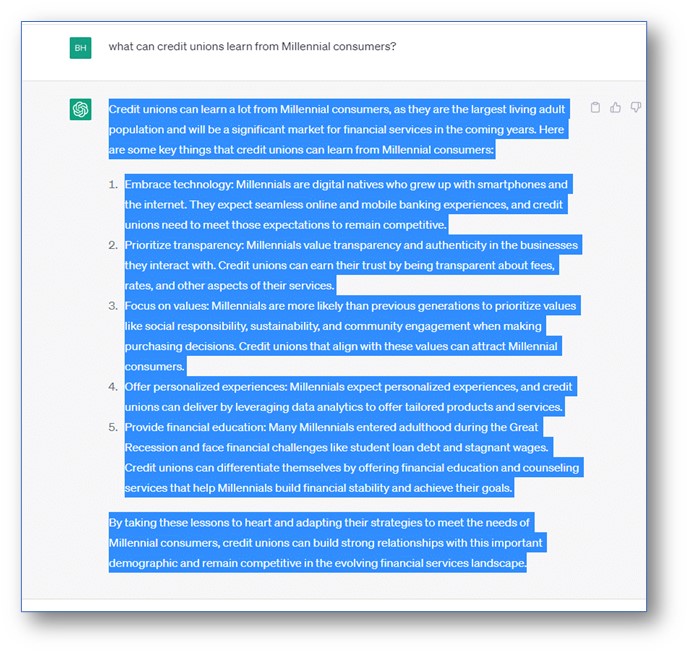President's Message

Asking ChatGPT “What can credit unions learn from Millennial consumers?” yields a telling result. Boiled down, the advice this Artificial Intelligence engine tells us to:
1) embrace technology
2) prioritize transparency
3) Focus on values
4) Offer personalized experiences, and
5) provide financial education.
Out of these five items, credit unions generally excel at four of them.
We prioritize transparency through our cooperative business model. Our depositors and borrowers own the company. We call them members the same way we refer to owners of an LLC. Our tax returns are available for public inspection. We mean what we say. While millennials value transparency and authenticity in the businesses they interact with, credit unions believe that every consumer deserves to know who they are dealing with and to have all the tools with which to make sound financial decisions.
We focus on values because we were born from the core cooperative principles that should strike a resonant chord with millennials who, as ChatGPT quite correctly notes, “are more likely than previous generations to prioritize values like social responsibility, sustainability, and community engagement when making purchasing decisions.”
Credit unions are grounded upon the personalized experiences they provide for members. Whether these experiences come through direct democratic control of the credit union by a volunteer board of directors sourced from the membership or by the CEO of a smaller credit union who counsels and advises members face-to-face, credit unions give the membership what it wants. This is not marketing “puffery” or just some simple slogan. Credit unions are designed to grow and succeed along with the growth and success of their members.
Financial education lies at the heart of every credit union. When members make good financial decisions, the credit union grows. When members need help making better financial decisions, it is in the credit union’s best interest to help them get that knowledge. In a small state like Connecticut, credit unions have provided financial education to tens of thousands of high schoolers and we have well over 100 trained financial counselors on staff at credit unions statewide. Again, ChatGPT is on the money: “Many millennials entered adulthood during the Great Recession and face financial challenges like student loan debt and stagnant wages.” The simple fact that this population has faced financial headwinds nearly their whole adult lives makes it easy to understand why they value a trusted financial partner who teaches them how to build financial stability and achieve their goals.
And then there is embracing technology. Especially for the smaller credit union, this is easy to say but seemingly expensive to do. So how can the credit union provide the seamless online and mobile banking experiences that millennials and Gen Z expect? Digital natives, the ones who grew up with smartphones and the internet, understand two things about technology that many of us do not: first, technology has to make their lives better in some way, and second, it just has to work. Credit unions cannot implement every digital bell and whistle available, and they don’t have to. Every credit union can use technology to improve their members’ lives in some way, however small.
Which technological enhancement can you bring to your credit union in 2023?
As Always,
Bruce


